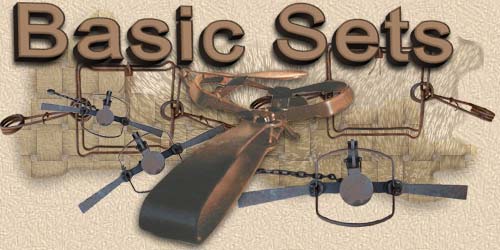

|
~~~~~~~~~~~~~~~~~~~~~~~~~~~~~~~~~~ |
| Some mink will spend
a lot of time in the water and others will spend a lot of time on the bank.
To improve your chances of catching mink, its a good idea to have a number
of different sets both in the water and on the land. Blind sets are
great mink catchers, but knowing where to put the trap is the key.
Mink are always hunting and traveling and have a long range.
One of the places mink like to travel is along a shore line. The place to try to intercept the mink here is where the mink is forced between a bank and an obstacle such as a stick. The mink will hug the steep bank as it makes its way through the tight spot. A well placed foothold of the #1 1/2 size coilspring or longspring as well as the #11 will do a good job at this set when rigged for drowning. This drawing shows trap placement from the top view. Notice the trap dog is facing the creek and the loose jaw is tight against the bank.
Drawing courtesy of James Grant Krause
There are also times when there will be a perfect set like this and a faint trail up on top of the steep bank. Its a good idea to set traps at both locations because there's no way of knowing which path the next mink will be taking. Here's a view of such a place. Notice the foothold is set in the water and the conibear is in the trail.
Drawing courtesy of James Grant Krause
These faint trails can be hard to see. If you ever have the opportunity to go out along a stream just after a snowfall, go looking for mink sign. The tracks left behind by the mink will tell you a lot about where the mink likes to travel. Here's a picture of a good location for a mink trail set.
Photo from Charles Dobbins' book Mink Trapping Techniques
Another thing to keep in mind is to look for where triangles meet. Where the triangles converge is usually a good location for a mink set. This is illustrated below.
Drawing courtesy of James Grant Krause
Mink will also travel under the water. When they do this they like to hug the bank. These underwater traveling mink can be caught in a conibear placed at a spot on the bottom where the bank or obstruction protruding from the bank makes a ninety degree angle. A fellow by the name of Ken Smythe made this set well known. Here's an example of a bottom edge set as it's known.
Drawing courtesy of James Grant Krause
Locations in a stream where this set works best is illustrated by the drawing below. Additionally, bridge abutments work great too.
Drawing courtesy of James Grant Krause
Here's a picture of an actual bottom edge set. Photo courtesy of James Grant Krause 
Animals used for: Mink - This set is very effective on mink. With a covering of winter ice on the creeks, this set becomes even more deadly. Muskrat - This set will readily catch muskrats also. Muskrats and mink use the same underwater travelways. |